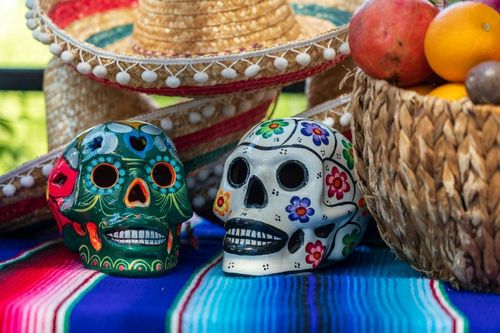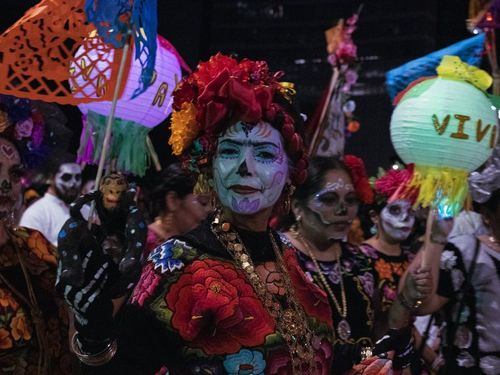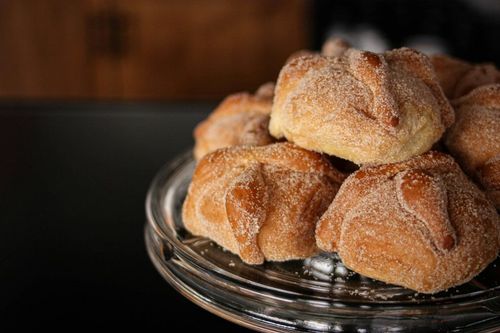The Day of the Dead (Spanish: El Día de los Muertos) is one of the most iconic celebrations in Spanish-speaking countries. Families honor and remember those who have passed away creating colorful altars adorned with photos and favorite foods. It’s a great way to turn sadness into a joyful festival of life and memory.
Join us as we uncover the beauty of this amazing Spanish tradition!

What is the Day of the Dead?
The Day of the Dead (Spanish: Día de los Muertos) is a Mexican holiday that takes place on November 1st and 2nd. It is a date on which families come together to remember their deceased relatives. They believe that the spirits of their loved ones return for a brief period. Interestingly, this holiday is a blend of indigenous traditions and Catholic beliefs.This celebration is very important for Mexican folks and has been happening since pre-Hispanic times. The Mexican people used to celebrate for two months in the summer. After the Spaniards brought the Catholic calendar, the celebration was moved to November 2nd to align with All Souls’ Day.

What's the History behind the Day of the Dead?
The origins of the Day of the Dead can be traced back to pre-Columbian cultures, mainly the Aztecs, who viewed death as an integral part of life. The Aztecs, along with other Nahua people in central Mexico, believed that death was a continuation of life. To honor the deceased, ancient cultures used skulls and wore costumes. They also donned masks, known as “carnitas”, to frighten the dead away at the end of the celebrations.Following the Spanish conquest, these indigenous traditions were added to Catholic practices. As a result, the holiday merged with Christian traditions such as All Saints’ Day and All Souls’ Day. Then day of the Dead in Spanish evolved into the celebration we know today.
Key Traditions of the Day of the Dead in Mexico City
In Mexico City, families create elaborate altars, known as “ofrendas”, to welcome and honor the spirits of their deceased loved ones. The vibrant “calaveras” (sugar skulls) are often intricately decorated and either given as gifts or placed on the altars. Orange marigolds, with their bright color and fragrance, are used to guide the souls to the altars, and they can be seen everywhere during the celebration.In addition, people dress as skeletons and participate in lively parades and festivals. Traditional Mexican dishes like tamales, “pan de muerto” (bread of the dead), and “mole” are enjoyed during this time.

How Spain Celebrates the Day of the Dead
Although the Day of the Dead is most often linked to Mexico, it is also celebrated in Spain and the Philippines. Spanish families gather to pray and share stories about their loved ones at home altars during the Day of the Dead They visit cemeteries to clean and decorate graves with flowers, especially chrysanthemums. Some wear shells on their clothes while dancing to wake the dead, while others dress as the dead.In contrast, the Mexican tradition comes from the belief that life on Earth prepares us for the afterlife. So, it is important to stay connected with the dead. Families gather in cemeteries to welcome the spirits back home. One of the biggest displays, the “Mega Ofrenda,” is set up in the Zócalo, Mexico City’s main square, during the Día de los Muertos celebration.
The Philippines also observed the Day of the Dead, known as “Undás” or “Araw ng mga Patay". During this family-centered holiday, Filipinos visit cemeteries to pray, light candles, and strengthen familial bonds. Although it is also called All Saints’ Day or All Souls’ Day, the primary focus is on honoring and remembering loved ones who have passed.
The Importance of Food in Día de los Muertos Celebrations
Food plays a central role in Día de los Muertos celebrations. From October 31st until November 3rd, families traditionally add food to the “ofrenda” each day. Different foods are offered depending on the age of the deceased being honored. Popular dishes include “pan de muerto”, tamales, mole, rice, beans, “pozole”, rice pudding, and fruits. Sugar skulls are also a common feature on the altars. A variety of drinks, such as hot chocolate, “atole”, and “Jarritos”, accompany the meals. These offerings are meant to nourish the spirits when they return.
Day of the Dead Mexican Symbols
Several symbols define the Day of the Dead in Mexican culture, including flowers, butterflies, and skulls. The cempasúchil, a type of marigold native to Mexico, is frequently placed on altars and graves. Its vibrant color and distinct fragrance help guide the spirits back to their families' homes. The petals are often arranged to create a path leading from the cemetery to the household altar.“Papel picado”, colorful paper cutouts, symbolize the fragility of life. Another iconic symbol is La Catrina, a skeleton figure representing a joyful acceptance of death.
Día de los Muertos in Popular Culture
In Mexican art and culture, Día de los Muertos is a celebration of life, emphasizing healing and acceptance of death. The holiday encourages people to confront the reality of death while also rejoicing in the belief that the spirits of loved ones return to be with their families during the festivities. Rather than mourning, the focus is on celebrating the lives of those who have passed.
Stay Connected During Day of the Dead with Yoho Mobile eSIM
If you are planning to travel to Mexico for the Day of the Dead you can stay connected using Yoho Mobile eSIM. For the Day of the Dead in Spain or the Philippines, you can also connect using Yoho Mobile eSIM and enhance your experience.
🎁 Special Discount for Our Readers!As a special treat for our readers, Yoho Mobile is offering an exclusive discount! Use our coupon code "YOHOREADERSAVE" to get your first order for FREE!Don’t miss out on this opportunity to stay connected affordably in Mexico. |
|
